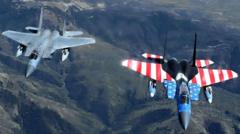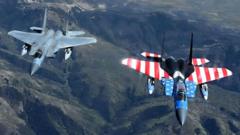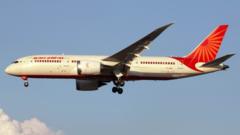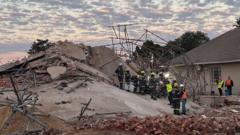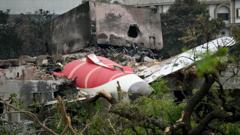Investigators are analyzing the cause of the Air India flight's crash, which has become a focal point in discussions about production standards and whistleblower claims.
**Boeing's 787 Dreamliner: Safety Record Under Scrutiny After Air India Tragedy**

**Boeing's 787 Dreamliner: Safety Record Under Scrutiny After Air India Tragedy**
The recent crash of a Boeing 787 Dreamliner has sparked concerns over the aircraft's safety despite its historically solid record.
The crash of Air India flight 171, which resulted in the tragic loss of over 270 lives just moments after takeoff, has raised serious questions regarding the Boeing 787 Dreamliner—previously hailed as one of the safest aircraft in the skies. With over a decade and a half in service without a single fatality, Boeing's 787 had carried more than a billion passengers until this shocking incident. As investigators comb through the recovered flight data, scrutiny has intensified around the aircraft's production processes, which have been marred by numerous whistleblower allegations.
The 787 Dreamliner was born from a period of high fuel costs and an industry need for efficiency. Conceived in the early 2000s, Boeing developed the aircraft with advanced technologies and materials that promised revolutionary fuel savings and reduced emissions. This approach diverged significantly from competitor Airbus, who focused on larger aircraft models. In a remarkable shift, the 787 introduced the use of composite materials and cutting-edge engine technology, aiming to achieve a 20% improvement in fuel efficiency compared to the older Boeing 767.
However, the 787's successful rollout encountered significant challenges early on, particularly concerning safety incidents involving overheating lithium-ion batteries, which led to a worldwide grounding of the fleet in 2013. While these operational difficulties have since stabilized, a cloud of production quality issues has lingered, exacerbated by the establishment of a new assembly line in North Charleston, South Carolina, that was intended to streamline production but allegedly compromised safety protocols.
Whistleblower allegations have surfaced over the years—from claims of damaged parts being used to pressure on workers to prioritize speed over quality. Two key whistleblowers, John Barnett and Cynthia Kitchens, revealed serious concerns about quality control, including improper handling of components and the installation of defective parts. Their assertions were partially upheld by the Federal Aviation Administration (FAA), which reported missing non-conforming parts and confirmed the presence of metal shavings in several aircraft.
Recent testimony from current Boeing employee Sam Salehpour echoed previous concerns, alleging that production shortcuts could lead to catastrophic failures in the 787 fleet. Boeing has consistently denied these claims, asserting that its aircraft maintain high safety standards and have undergone rigorous inspections under FAA oversight.
Despite the concerning allegations and recent tragedy, some aviation experts maintain confidence in the 787's overall safety record, pointing to its lengthy operation history and lack of significant crashes prior to the Air India incident. Nonetheless, organizations like the Foundation for Aviation Safety are adamant that unresolved safety issues do exist, particularly concerning water leakage into electronic compartments, indicating a potential risk that cannot be ignored.
As investigators work to uncover the cause of the Air India crash, there is a collective urgency to ensure the safety of the 787 Dreamliner and restore public confidence in Boeing's commitment to passenger safety. Moving forward, the aviation community stresses the importance of continued oversight and transparency in the manufacturing process to prevent future tragedies.
The 787 Dreamliner was born from a period of high fuel costs and an industry need for efficiency. Conceived in the early 2000s, Boeing developed the aircraft with advanced technologies and materials that promised revolutionary fuel savings and reduced emissions. This approach diverged significantly from competitor Airbus, who focused on larger aircraft models. In a remarkable shift, the 787 introduced the use of composite materials and cutting-edge engine technology, aiming to achieve a 20% improvement in fuel efficiency compared to the older Boeing 767.
However, the 787's successful rollout encountered significant challenges early on, particularly concerning safety incidents involving overheating lithium-ion batteries, which led to a worldwide grounding of the fleet in 2013. While these operational difficulties have since stabilized, a cloud of production quality issues has lingered, exacerbated by the establishment of a new assembly line in North Charleston, South Carolina, that was intended to streamline production but allegedly compromised safety protocols.
Whistleblower allegations have surfaced over the years—from claims of damaged parts being used to pressure on workers to prioritize speed over quality. Two key whistleblowers, John Barnett and Cynthia Kitchens, revealed serious concerns about quality control, including improper handling of components and the installation of defective parts. Their assertions were partially upheld by the Federal Aviation Administration (FAA), which reported missing non-conforming parts and confirmed the presence of metal shavings in several aircraft.
Recent testimony from current Boeing employee Sam Salehpour echoed previous concerns, alleging that production shortcuts could lead to catastrophic failures in the 787 fleet. Boeing has consistently denied these claims, asserting that its aircraft maintain high safety standards and have undergone rigorous inspections under FAA oversight.
Despite the concerning allegations and recent tragedy, some aviation experts maintain confidence in the 787's overall safety record, pointing to its lengthy operation history and lack of significant crashes prior to the Air India incident. Nonetheless, organizations like the Foundation for Aviation Safety are adamant that unresolved safety issues do exist, particularly concerning water leakage into electronic compartments, indicating a potential risk that cannot be ignored.
As investigators work to uncover the cause of the Air India crash, there is a collective urgency to ensure the safety of the 787 Dreamliner and restore public confidence in Boeing's commitment to passenger safety. Moving forward, the aviation community stresses the importance of continued oversight and transparency in the manufacturing process to prevent future tragedies.







